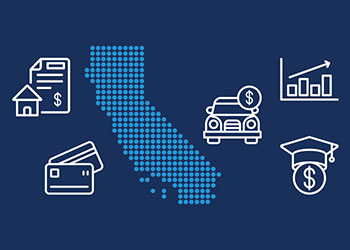Updated California Credit Dashboard Includes New Snapshot of Key Trends – Such as Rising Delinquencies
- By:
- Category:

March 22, 2024, Berkeley, CA — The nonpartisan California Policy Lab posted updated data to the California Credit Dashboard today, with data through the fourth quarter of 2023.
“The Dashboard provides a near real-time snapshot of how Californians are faring financially,” explains Evan White, Executive Director of the California Policy Lab’s UC Berkeley site, and a member of the research team that created and maintains the dashboard. “Unfortunately, there are increasing signs of financial distress, and almost six percent of all loans are delinquent, a figure that’s more than double the number of delinquencies from mid-2021.”
New feature: The Dashboard includes a new California Financial Trends snapshot that describes recent changes in credit scores, delinquencies, monthly payments, and new loan amounts. Both short- and long-term trends are included, and are drawn from the Dashboard data.
3 example trends from the new snapshot:
New mortgage amounts trending down: The average new mortgage amount in California in the last quarter of 2023 was $560,250, representing a 4.6% decrease from the 3rd quarter of 2023 and a 4.4% decrease from Q4 2022. See more.
Generation X has the highest monthly debt payments: Gen X (ages 42-57) has the highest total amount of monthly debt payments ($450), which is 38.9% higher than the average of all other generations combined. See more.
Delinquencies are highest in the Central Valley: The 30-day delinquency rate was highest in the San Joaquin Valley region, with 8.7% of all loans delinquent – a rate that is 3.2 percentage points higher than the average of all other regions combined. See more.
See 5 additional trends on the Financial Trends snapshot.
The interactive Dashboard includes 10 longitudinal charts for 6 types of debt (auto, credit card, home equity, mortgage, student, and other) and collections. The 10 figures can be sorted by 7 age groups, 9 economic regions, and 5 credit ratings. The Dashboard also includes 4 county-level maps which can be filtered by generation, loan type, credit score, and timeframe (2004 to present).
Using the interactive the maps, users can compare:
- Delinquency rates
- New loan amounts
- Monthly payments
- Credit score trends
Note: The California Policy Lab’s Data Point, Introducing the California Credit Dashboard, shows examples of how the figures can be adjusted to show differences by region, generation, and credit ratings.
More about the California Credit Dashboard
The Dashboard uses credit-bureau data from the University of California Consumer Credit Panel. All figures in the Dashboard are based on a 2% random sample of individuals. Where applicable, the results are multiplied by 50 to obtain the full-population estimate. A technical appendix provides detailed information about the data and underlying research. Several dozen faculty and graduate students from the University of California currently use this dataset for research.
